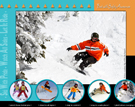 |
||
 |
 |
|
![]()
|
Conditioning
• The Code • Helmets • Conditioning • Check List • Layering •
If you haven't done any specific cross-training, the muscles that have been relatively dormant for the summer are going to rebel and hurt. The six weeks before the season are the most important for both strength training and anaerobic conditioning. Even if you haven't been conscientious about training throughout the off-season, you should participate in a program before hitting the slopes. There are three main areas you need to concentrate on to get you safely on the slopes. The objective should be to build an aerobic base while increasing strength and flexibility. In any conditioning program the first step is to identify the intensity level of your skiing/boarding and make sure the exercises you perform will match it. It's important to stretch everyday and incorporate some form of aerobic training three to six times per week. While more is better, exercise sessions should be at least 30 minutes at a low intensity. Anaerobic work should be incorporated at least two to three days per week, and one rest day is crucial. Finally, you should do a warm-up before any exercise and a cool-down afterwards. Aerobics Timing is important, so that as the season approaches, you increase the intensity and challenge of your workouts, moving from a primarily aerobic to more of an anaerobic focus. For instance, you can incorporate two-minute sprint intervals into a session of running or biking, with a rest period afterward. In addition to running and biking, there are a variety of excellent training activities that are specific to skiing and boarding: hill running, stair climbing, using a ski machine, and inline skating.
Strength Training By targeting major muscle groups in the upper body, you should see significant gains in strength and fitness levels. Focuses on leg work should involve the calves, quadriceps, hamstrings, and gluteals. You need to train your lower back and your hamstrings to balance out opposing muscles like the quads and abdominals. Still recovering from cartilage surgery last spring, Mannetter says he tries to isolate specific leg muscles used in skiing. "For example, it'sIt is very common for skiers' legs to be stronger on the outside so it's important to get the inside of the leg strong so the kneecap can be held centered. Using free weights will also give you more results for your time spent lifting. When you're wedged against an apparatus while lifting, muscle groups are isolated. Free weights force balance and range of motion that resembles skiing and boarding. Flexibility • The Code • Helmets • Conditioning • Check List • Layering •
|
|
Some Articles to Download
|
|
| 2016-09 Build Your Legs | |
| 2015-12 Conditioning | |
| 2015-06 Year Round Conditioning | |
| 2014-12 Workout | |
| 2014-09 Banana Power | |
| 2014-06 Yoga for Core | |
| 2014-03 Ski Circuit | |
| 2013-09 Strengthen Knees | |
| 2013-06 Yoga | |
| 2013-03 Stretching | |
| 2012-12 Stretching | |
| 2012-12 Diet | |
Email us at info@pacificrimalliance.org
Contents of this site Copyright © 1997-2019 by Pacific Rim Alliance. All rights reserved.
Site designed & maintained by Graphic Dezignz. Last updated October 17, 2017.
 |
 |
Skiing is a Dance in which the Mountain always Leads





